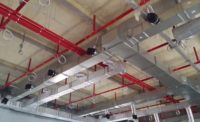Picking up from my last article in the June 2019 issue, I will explore some context for real-world life safety applications. In this article, I’ll focus on complying with NFPA 99 (Section references to 2018 ed.) and its referenced standards as resources for your health care facilities’ HVAC designs. Once again, I’ll go a little deeper into developing the discipline needed to avoid the propensity for wishful thinking in the world of design and commissioning.
The goal is to improve your understanding around the interplay of requirements needed to maintain life safety under a “defend in place” health care setting as it pertains to the design of mechanical ventilation systems as the NFPA 99 criteria is integrated with the general criteria from NFPA 90A and smoke control criteria from NFPA 92.
Nonambulatory health care settings present unique design challenges
The populations within non-ambulatory health care settings are exceptionally vulnerable. Many patients are unable to take the necessary steps toward self-preservation during an emergency. This situation places special obligations on the staff who must be able to react during an emergency in a manner that includes the secure relocation of patients who are at direct risk during the emergency. Bedridden patients cannot be quickly relocated vertically within a building. Therefore, these kinds of occupancies are of the select few where compartmentalization is mandated across each floor by both the International Building Code and the Life Safety Code. Careful coordination of the compartments and resultant zoning of the associated life safety systems allow for horizontal relocation of the vulnerable population by carefully trained staff during the emergency. Compartmentalization is achieved through smoke barrier construction along the boundaries of each compartment.
Generally, a simplistic approach to compliance in this regard might be expected. So, could we accomplish this goal by unilateral provision of appropriately rated doors that are on automatic release service through the fire alarm and detection system along with similarly operated smoke dampers wherever the HVAC ductwork penetrates these smoke barriers? Sadly, it just isn’t that easy if we want to satisfy all of the relevant criteria. If smoke zone boundary walls coincide with other required fire barriers serving other intents, then the ductwork penetrations may entail different protectives (i.e. combination fire/smoke dampers) just like the hourly fire-resistive rating of the doors would be expected to increase in order to serve both fire and smoke purposes in step with the barrier’s hourly rating. And, we must recognize that opening protectives can also be counterproductive, if not outright prohibited.
This is the point where careful consideration is required. From my earlier articles, we know what may appear to be a simple design situation can often be more complex. This is because more seemingly complex design options might actually afford the flexibility that is needed to more readily accomplish multiple design objectives.
To discover these potential pitfalls, we must first consider the results of our emergency response. A smoke detector or sprinkler flow initiates our response. The boundary doors close, and our dampers close. Air-handling equipment generally shuts down, but if not directly affected, may continue to run … indeed, we may want, even need, the equipment to keep running.
Life safety has many faces
NFPA 99 demands special attention to ventilation for many purposes where gases or processes produce hazardous conditions, including:
- Laboratories (see also NFPA 45, Section 9.3.1.2);
- Isolation rooms (positive or negative air pressure, see ASHRAE 170);
- Medical gas storage/cryogenic fluids (Section 9.3.6.5.3);
- Medical plume evacuation (Section 9.3.8); and
- Waste gas (Section 9.3.7).
Understand the potential risk for interrupting these systems as a starting point. Next is understanding where dedicated HVAC equipment and ductwork is mandated and their allowable means of makeup air. Keep a copy of NFPA 55 at hand as you will find it to be a repeating reference standard in some of these areas.
Ductwork associated with HVAC systems in these spaces must also comply with NFPA 90A (Section 9.3.5) where natural ventilation is not an option (see also ASHRAE 170, Section 9.3.1.1). Maintaining air pressure differentials for these special spaces is a minimum requirement.
Space planning can place many of these locations more or less remotely from the patient care areas, while others are inherently required to be collocated with patient care and treatment spaces. When you consider these requirements in the context of our “simple” compartmentalization solution, you will quickly recognize prohibitions against dampers that would interfere with the air service or otherwise represent a hazard in their service or maintenance within patient care and treatment areas. General shutdown service for associated equipment then should also be avoided unless confirmed to have no adverse impact.
And, not only must we consider where to safely locate exhaust discharge points (e.g. Sections 9.3.6.6 and 9.3.8.2), but, further, we must consider the impact of pressure changes induced by changes in the condition of the other HVAC systems being driven by the fire emergency. Since the adverse pressure effects may be adjacent to the actual areas being directly affected by the fire, intelligent design addresses the functionality of these other systems during such events as well as the regular testing, inspection, and maintenance of the related life safety systems.
There are likely going to be multiple exhaust points even within a single compartment, where general shutdown of other HVAC equipment or blanket closure of perimeter dampers will induce out-of-the-ordinary air pressures, both within and adjacent to the primary compartment. Where non-dedicated exhaust is allowed, cross-connecting separate smoke compartments with these systems remains a concern. It’s also important to recognize that you cannot discard these implications as too rare to consider, even though fire is a rare event. Regular testing of the life safety systems is mandated such that these implications are then part of the design by necessity. These conflicting conditions will happen regularly.
I, for one, would not want to have to explain under any circumstances why my design left an isolation room unable to serve its negative or positive air pressure requirement(s) during periodic life safety testing, let alone a real emergency of unknown duration, particularly when the subject space is not directly affected by the incident at hand. For that matter, the same goes for any of the special spaces itemized from NFPA 99 in our earlier list. Depending on potential adverse outcomes, the impact of the fire emergency might turn out to be minor compared to other consequences, particularly if only a false alarm, which is statistically much more common than a fire itself.
Setting about addressing these challenges properly, we can remain with the “simple” compartment solution for the time being. Imagine an excess bounding air pressure induced by the sudden closure of most, but not all, of the dampers for any given piece of equipment with ductwork crossing along an adjacent smoke zone. Has all of the HVAC equipment and associated ductwork been closely coordinated to avoid this adverse outcome for all possible scenarios of fire origin? Likely not. The ability to maintain life cycle balance maintenance should weigh heavily in our minds. Introducing dynamic controls and monitoring into the design begins to make sense.
Choosing robust functionality across multiple regulatory criteria can involve hard but necessary decisions. Otherwise, we succumb to turning a blind eye by designing to failure for the sake of simplicity. License to omit a damper is one thing, while appropriate compensation for the omission is another. Ignoring the issue altogether is designing to failure, one way or another, so designing to success then, on all fronts, is imperative.
Omitting potentially unhelpful dampers from the situation can run the gamut of necessary compensating design features, but you can expect to incur a fire-resistive rating (assigned by the wall/floor assemblies being penetrated) for the affected ductwork. Remember to pick up any higher hourly ratings along the way if multiple fire-resistive assemblies are penetrated along the duct path.
A conventional solution to the ‘simple’ problem
From the very thin list of actual approved gypsum wallboard assemblies that are available to compliantly protect a horizontal duct, we know an equal or greater fire-resistive rated wall is required for continuity support of a horizontal enclosure with an “L-shape” profile — for at least up to about a 60-inch duct width. Unfortunately, fire-resistive rated walls running along the duct path with the correct hourly rating are likely non-existent in the space, so plan to provide the necessary continuity support. Therefore, we are probably looking at fire-resistive rated duct assemblies to accomplish the protection. Remember, the damper, penetrated wall assemblies, and gypsum wallboard assemblies are all properly protecting for fire exposure from either side or from fire inside or outside, per the language of NFPA 90A.
This concept drives selection of Duct B fire-rated duct assemblies for ISO 6944-tested fire-rated duct assemblies. This would be Conditions C and D for fire-rated duct assemblies tested to ASTM E2816, depending on duct orientation. All current evaluation service reports for fire-rated duct assemblies require Duct B or Conditions C/D for fire-rated duct assemblies that are serving as either shaft replacement or damper omission purposes.
If you were planning on using a “U-shape” profile for your horizontal gypsum wallboard enclosure, please stop. You won’t find it in GA-600, the UL fire-resistance directory, or anywhere else for that matter. If you think you’ve found one, please call me or the Gypsum Association before proceeding. If your duct width is greater than 60 inches, you will need to plan on a fire-rated wall on both sides of the duct to provide the necessary continuity support. In the unlikely event there are fire-resistive rated wall(s) with the correct hourly rating along the duct path, keep an eye on your minimum headroom underneath the horizontal gypsum wallboard assemblies. All compliant gypsum wallboard assemblies will have horizontal member thicknesses greater than the vertical member of the assembly.
Robust design options are out there
Here are some final cautionary statements about vertical or horizontal gypsum wallboard enclosures.
When we are directed to design “dedicated” systems, that includes the fire-resistance rated enclosures. Multiple ducts cannot be ganged together within a common enclosure for dedicated systems or we risk short circuiting unprotected penetrations of separate compartments along the duct run. So, be particularly aware of crossing duct runs. If the horizontal separation along with actual duct depth came in within available allowable headroom tolerances for a single duct run, then crossing ductwork for dedicated systems will require a horizontal fire-rated assembly beneath each duct, even between the ducts. That means we must account for each duct’s depth plus the depth of two horizontal assemblies along with some reasonable tolerance for hanging the ducts.
If all of this isn’t enough to keep your eyes on, there is the matter of other utilities running in parallel with and crossing these duct runs. NFPA 90A prohibits piping and utilities that are combustible themselves or carrying hazardous contents from sharing the same shaft as any ventilation ductwork, including our subject HVAC systems. Accordingly, these other utilities may not cross through, let alone share, our subject enclosures.
It becomes apparent why fire-rated duct systems come to bear in these situations instead of gypsum wallboard enclosures. These days, even the vertical shafts are accomplished with ASTM E119-tested fire-rated ductwork assemblies that actually provide greater flexibility with respect to proximate combustible utilities, smaller footprints, and improved schedules at lower costs than the conventional gypsum wallboard shaft construction in many instances.
Active smoke control systems — actually more complex?
When we’re designing to protect vulnerable populations, we must pay attention to all the little details. In some respects, we find the “simple” solution can be a more complex problem when we consider and overlay the ventilation requirements of NFPA 99 with the demands of the local Building Code and Life Safety Code (NFPA 101) for Joint Commission compliance. On the other hand, what can often be considered a more “complex” approach toward satisfying the compartmentation and smoke migration challenges of these health care occupancies might just be more flexible and robust in all the right spaces.
Applying the pressure method across smoke compartments seems predisposed to unwanted air pressures when it comes to these special spaces from NFPA 99. In actuality, the probability of successfully controlling these pressures across the full range of normal, testing/maintenance, and emergency conditions increases for several reasons. Spend your budget allowance carefully and provide your client with a more robust design with lower life cycle costs and expect a lifelong relationship. Many stakeholders will find this might be attractive in comparison to the “simple” solution.
With the “simple” approach, the cost considerations begin with many access panels, actuators, controls, and secondary power feeds along with supervision and activation accessories, all of which will easily exceed the cost of the actual dampers they serve, which are at the heart of compartment perimeter fire/smoke containment. Also, minimally required will be fire-rating ductwork, which becomes necessary whenever omitting dampers that would interfere with our NFPA 99 ventilation requirements. This approach offsets the upfront cost of what otherwise would be spent on dampers and their accompanying accessory costs. Moreover, the life cycle cost difference between all of the omitted equipment versus passive fire-rated ductwork needs to be part of the calculus. Regularly inspecting, testing, and maintaining the dampers and their accessories, not to mention the access problems associated with doing so inside patient care areas, are non-existent with fire-rated ductwork. Comparing the mechanical budget cost of SMACNA ductwork against fire-rated ductwork doesn’t quite capture the full picture. By applying the pressure method to improve boundary performance, without the need for so many dampers, becomes an exercise in reallocating up-front and life cycle costs.
A deeper approach toward magnified benefits for multiple stakeholders
Further, this approach is not restricted to these NFPA 99-regulated spaces and their dedicated mechanical systems. Careful design can capture the normally provided HVAC equipment serving the daily ventilation, heating, and cooling needs of the affected smoke compartments. By assignment as non-dedicated smoke control equipment, their performance can compliantly eliminate many dampers along smoke compartment boundaries. Robust design options become available for the selection and implementation of these systems when we embrace this approach. Monitoring of both dedicated and non-dedicated equipment improves reliability in an area that is one of the more common deficiencies cited by the Joint Commission as related to these special negative and positive pressure spaces within health care facilities.
Expanding the concept to encompass the pressure method for fire emergency HVAC performance increases the flexibility to steer dynamic controls to higher capacity equipment during design. The result is greater dynamic range to better accommodate the challenges of the many layers of performance expected in a health care setting where we are obligated to address so many sources of criteria and objectives.
Applying the pressure method along with selective application of fire-rated ductwork across the affected compartments drives some necessary enhancements:
- Small footprint vertical fire-rated duct shaft replacements;
- Non-dedicated HVAC equipment serving normal and smoke control duties; and
- Selective horizontal fire-rated duct for certain compartment boundaries.
But, where boundary conditions are achieved by this configuration without wholesale application of dampers at the boundaries, and where smoke control performance would be impeded by such dampers, this very configuration is not only allowed but demanded by the relevant codes and standards. Moreover, you will be bringing to your client a design that:
- Inherently improves the reliability of the non-dedicated equipment;
- Mitigates potential for interference with our NFPA 99 ventilation requirements; and
- Reallocates upfront costs to achieve reduced life cycle costs.
This possibility should appeal to many stakeholders in the health care sector from the construction process on through to daily operations. We know wasted time and resources in the construction and operation of health care facilities are common occurrences. Working across multiple trades, there is the opportunity to design, construct, operate, and maintain high-performing facilities. The challenges are complex, but the solutions can be elegant.






